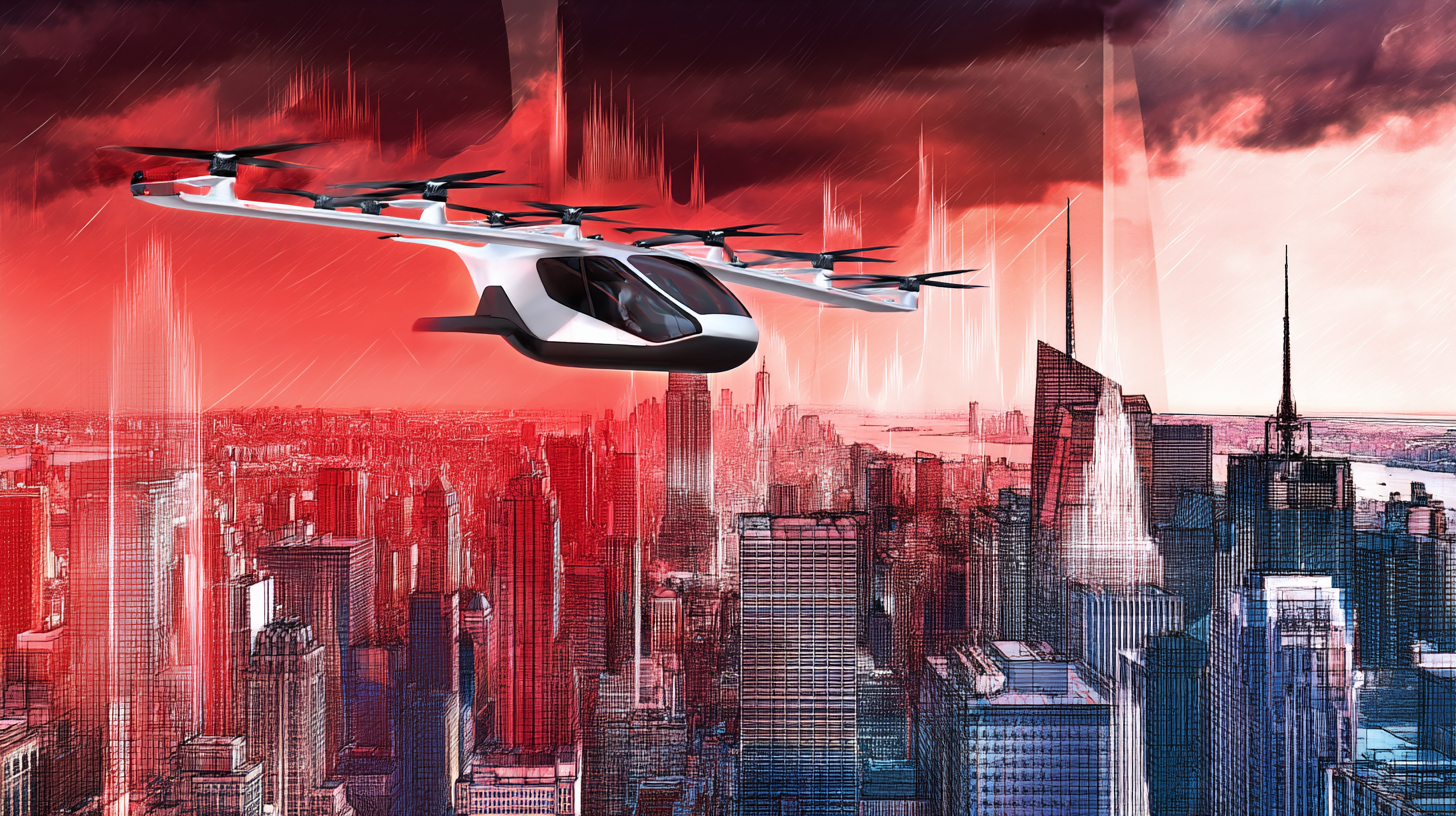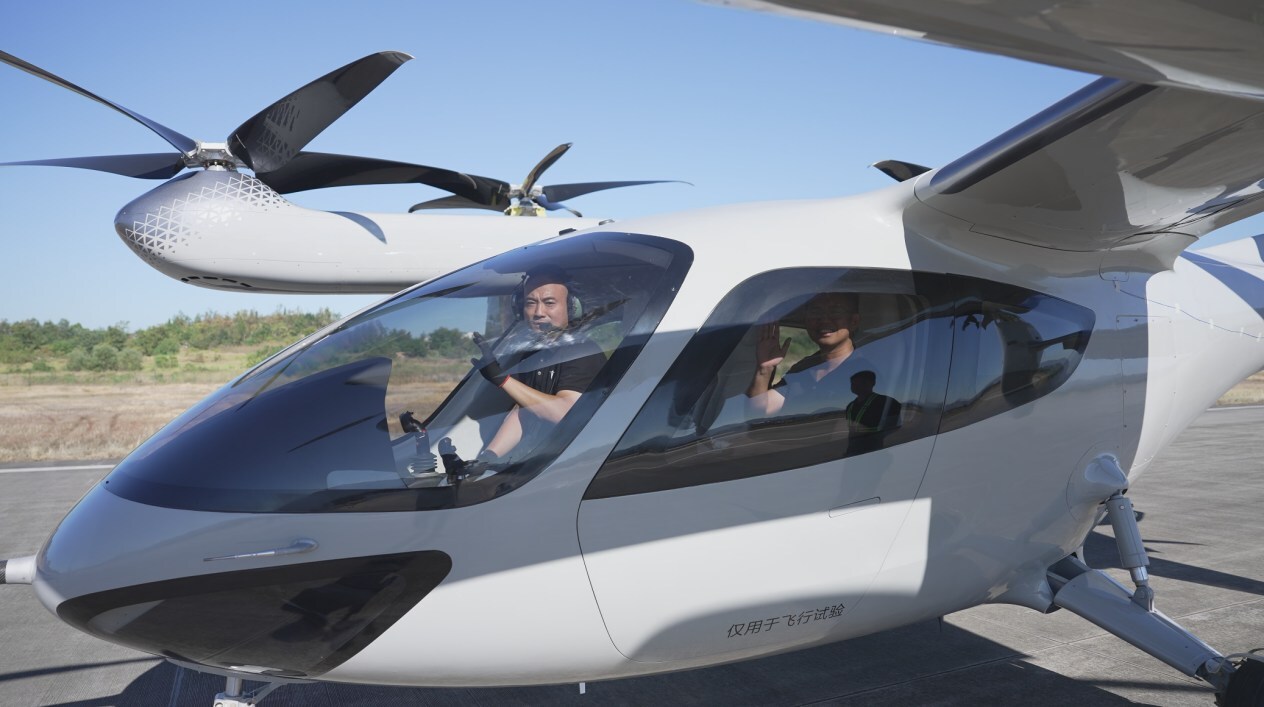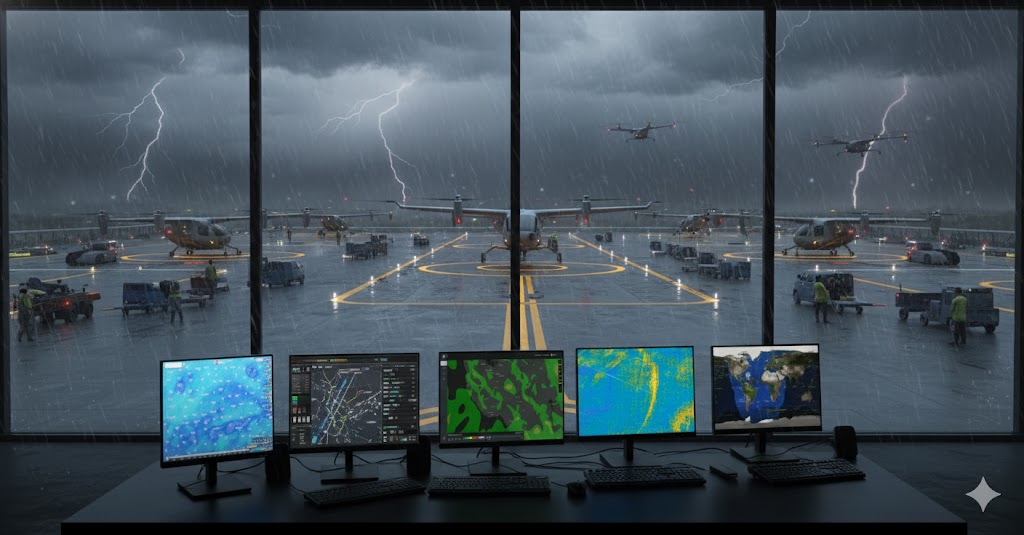China dominates the unmanned aerial systems market in the United States with its cost-effective, high-performance drones. However, the entry of manned eVTOLs, passenger-carrying aircraft like EHang’s EH216-S, into the U.S. market is stymied by a complex array of regulatory recognition, high tariffs, geopolitical tensions, and concerns about national security.
This divergence persists despite China’s groundbreaking achievement of the world’s first eVTOL type certification through EHang’s CAAC-approved EH216-S in October 2023 and subsequent domestic commercial launches. This contrasting reception highlights key differences in risk tolerance and competition. While low-stakes drone market entry faces little resistance, the high-stakes advanced air mobility industry faces strict scrutiny due to the combination of aviation safety requirements, dual-use technology concerns, and intense technological competition.
Where consumer drones benefited from pre-existing FCC approvals and grandfather clauses, manned eVTOLs face a protectionist landscape hardened by a 145% tariff structure, FAA certification skepticism, and Congressional measures targeting Chinese aviation technology transfers, creating barriers that render U.S. market access economically and politically untenable despite Chinese technical achievements.
This challenge has pressed Chinese manufacturers to strategically pivot toward more receptive international markets, where regulatory frameworks are more flexible and political relationships remain conducive to Chinese technology partnerships. The divergent approaches across global regions highlight the fragmented nature of the emerging eVTOL market and underscore the significant role that geopolitics plays in shaping the future of advanced air mobility.
Regulatory Non-Recognition and Certification Hurdles
The primary obstacle for Chinese eVTOL manufacturers in the U.S. market is the fundamental lack of mutual recognition for certification standards, despite China's early lead in this area. EHang’s EH216-S achieved the world's first eVTOL type certification from the Civil Aviation Administration of China (CAAC) in October 2023, a significant milestone that nonetheless faces extremely limited acceptance in Western markets. The U.S. Federal Aviation Administration (FAA) and the European Union Aviation Safety Agency (EASA) maintain bilateral airworthiness agreements with China, such as the FAA-CAAC Bilateral Aviation Safety Agreement (BASA), which theoretically provides a pathway for mutual certification recognition. However, political tensions and deep-seated safety considerations mean these agencies will not simply accept a Chinese eVTOL approval without conducting their own exhaustive review processes, effectively eroding the "mutual confidence and trust" required for streamlined approvals.
This regulatory skepticism is evident in the FAA's bifurcated approach to Chinese aviation technology. While consumer drones have benefited from existing FCC approvals and grandfather clauses, manned eVTOLs confront an entirely different and more stringent regulatory environment. The FAA’s creation of a new powered lift aircraft category in 2024, the first new category since helicopters in the 1940s, introduces performance-based rules for pilot training, operational visibility, and airworthiness that diverge sharply from the CAAC framework. Skepticism is further accentuated by the FAA’s effective rejection of CAAC’s 2023 type certification for the EH216-S.
Western regulators perceive Chinese eVTOL certification as operating under less stringent requirements than those mandated by the FAA or EASA, which enforce catastrophic failure probabilities typically requiring less than one in one billion occurrence rates.
The regulatory flexibility that enabled China's rapid certification progress paradoxically creates significant skepticism in Western markets. China's low-altitude economy is sometimes perceived as less stringently regulated and, therefore, less safe.
This perception gap, coupled with the FAA’s cautious timeline projecting initial U.S. eVTOL certifications no earlier than 2027, creates a substantial hurdle for Chinese manufacturers seeking to demonstrate the safety and reliability of their aircraft to U.S. regulators and consumers, further disadvantaging them as they navigate parallel and often non-reciprocal regulatory processes.
Competitive Implications and Future Market Dynamics
The certification misalignment and regulatory barriers could confine China's early lead in eVTOL deployment largely to domestic and select international markets unless future harmonization of international standards occurs. This fragmentation could ultimately benefit US eVTOL manufacturers by providing protection from early Chinese competition, but it also risks isolating the US from rapid technological developments occurring in China's more permissive regulatory environment.
The development of parallel certification systems and market structures creates the potential for divergent technological standards and operational practices. China's push for regulatory efficiency and technological independence suggests that the influence of US standards may diminish over time as China develops alternative frameworks and pursues global market leadership.
Precedent from Larger Aircraft Programs
The certification challenges facing Chinese eVTOL manufacturers mirror the experiences of larger Chinese aircraft programs, providing a sobering precedent for market access difficulties. China's COMAC airliners, including the ARJ21 and C919, have secured Chinese certification but still lack FAA and EASA approval years later, partly due to geopolitical frictions. However, some progress has been made in select markets, as evidenced by Indonesia becoming the first overseas country to validate the ARJ21's Chinese type certificate, with Trans Nusa poised to become the first overseas operator of the aircraft. This selective international recognition demonstrates that breaking into Western regulatory systems remains challenging.
A bilateral certification framework exists between the US and China through the FAA-CAAC Implementation Procedures for Airworthiness, which creates mutual recognition of technical standards based on confidence and trust between the authorities. However, these formal procedures operate alongside growing strategic competition.
Trade War Impact and Supply Chain Disruption
The ongoing US-China trade war has established severe financial barriers that effectively price Chinese eVTOL aircraft out of the American market. The US has imposed substantial tariffs on Chinese goods, with recent announcements including a new 30% baseline tariff on goods from mainland China and a staggering 102.5% to 145% tariff specifically targeting Chinese electric vehicles. While these tariffs specifically target electric vehicles, eVTOL aircraft would likely face similar or higher tariffs given their advanced technology classification and strategic importance to future transportation systems.
President Donald Trump's announcement of a 10% minimum baseline tariff rate on almost all foreign imports into the US was notably augmented by a 104% levy on Chinese goods, with US tariffs on Chinese-made goods subsequently jumping to 145%. These prohibitive tariff levels create impossible cost barriers for Chinese eVTOL manufacturers attempting to compete in the US market, making their products uncompetitive regardless of their technical capabilities or safety records.
Beyond direct tariff impacts, the trade war is forcing companies to re-evaluate their supply chain strategies, reshuffling global production networks in ways that affect Chinese eVTOL manufacturers' ability to integrate US-made components or establish US-based service networks. This disruption extends throughout the aerospace supply chain, limiting Chinese manufacturers' access to critical components and technologies that might enhance their aircraft's capabilities or facilitate US market entry.
Interestingly, EHang has positioned itself to weather these trade challenges by maintaining supply chain independence from US-controlled technologies. The company confirmed that recent tariff developments between China and the United States are not expected to have any material impact on its operations, clarifying that it does not rely on components originating in the US. EHang emphasized that it does not use US-restricted semiconductors, aerospace components, or other controlled technologies, ensuring no operational disruption due to trade policy changes.
Geopolitical Tensions and National Security Considerations
US lawmakers are expressing concern about Chinese dominance in aerospace manufacturing, particularly in the drone market, where Chinese firms have achieved market leadership, much to the dismay of American policymakers. If Chinese eVTOL manufacturers attempted to enter the US market, it would likely provoke significant backlash and prompt US officials to propose measures to counter China's lead in this emerging aviation technology. This political resistance operates independently of technical merit or safety considerations, creating an additional layer of barriers beyond regulatory and economic challenges.
The dual-use nature of eVTOL technology creates particularly sensitive national security considerations. Export controls on dual-use technology could restrict what Chinese companies can build or demonstrate, and US companies with Pentagon research contracts could find themselves in legal difficulties if they attempt to work closely with Chinese eVTOL manufacturers. Several eVTOL startups have received Department of Defense grants, creating potential conflicts of interest that would complicate any partnership or technology-sharing arrangements with Chinese firms.
Intellectual Property and Technology Transfer Concerns
Western aerospace firms remain cautious about manufacturing in China due to intellectual property leakage risks, and there are persistent concerns about sharing proprietary knowledge with Chinese partners. This wariness extends to accepting Chinese-developed aircraft that might incorporate proprietary Western technology or pose competitive threats to US manufacturers. The historical precedent of technology transfer requirements for market access in China has created long-standing skepticism about the protection of intellectual property rights in collaborative arrangements.
These concerns are compounded by the strategic competition between the US and China in emerging technologies. Beijing's apparent strategy of expanding Chinese manufacturers' market share and establishing Chinese technological standards as global ones suggests a fundamental shift from following US standards to creating competing international frameworks. This strategic independence goal creates additional tension in US-China aviation relationships and reinforces American resistance to Chinese technology adoption.
Chinese Strategic Pivot to Alternative Markets
Chinese eVTOL companies have strategically pivoted toward "eVTOL diplomacy" by forging partnerships, agreements, and collaborations with foreign entities in regions more receptive to Chinese technology. EHang has been particularly active in this approach, establishing operations in the United Arab Emirates and conducting successful demonstration flights in multiple international markets.
EHang's international expansion strategy has yielded significant results in the Middle East region. The company completed its maiden flight in Abu Dhabi as part of plans to launch commercial flights in the UAE and other parts of the Middle East. The company's founder and CEO emphasized their commitment to actively fostering collaboration and communication between the UAE's General Civil Aviation Authority and China's CAAC to expedite progress toward commercial operations. This approach demonstrates how Chinese manufacturers can leverage supportive regulatory environments and strong bilateral relationships to establish market presence outside of Western markets.
The company has also achieved notable success in Saudi Arabia, where its EH216-S completed its first autonomous air taxi flight in Mecca with support from local authorities, including the General Authority of Civil Aviation, the Ministry of Transport and Logistics Services, the Ministry of Hajj, and the Ministry of Interior. These demonstrations in high-profile locations with government support validate Chinese eVTOL technology and help establish operational precedents in strategic markets.
European Market Penetration
Chinese eVTOL manufacturers have also made significant inroads into European markets, leveraging existing bilateral aviation agreements and demonstrating their technology's capabilities in advanced regulatory environments. EHang made the first urban flight of a pilotless eVTOL aircraft in Europe, describing its EH216-S flight in Benidorm, Spain, as "a pivotal step in the future of urban aviation". This milestone flight was conducted as part of the European Union's U-ELCOME program, coordinated by Eurocontrol, and operated simultaneously alongside up to 12 additional drones in a dedicated U-Space environment.
The success of these European demonstrations is facilitated by the EU-China Bilateral Aviation Safety Agreement, which came into effect in September 2020. This agreement enables reciprocal acceptance of compliance findings and certificates issued by either party's competent authorities. This agreement facilitates the free circulation of civil aeronautical products and services between the EU and China and promotes cooperation in achieving high levels of civil aviation safety and environmental compatibility. The bilateral framework provides a more supportive regulatory environment for Chinese eVTOL manufacturers compared to the challenging landscape they face in the United States.
Latin America Market Opportunities
Latin America has emerged as the fastest-growing region in the global eVTOL market through 2035, presenting significant opportunities for Chinese manufacturers seeking alternatives to the challenging US market. The region's unique geographic and infrastructural characteristics create compelling use cases for eVTOL technology. Major cities such as São Paulo, Mexico City, Bogotá, and Lima suffer from severe traffic congestion, while traditional transport systems are overstressed and underdeveloped. Latin America's complex geography, including mountainous terrain, dense rainforests, and widespread archipelagos, complicates ground-based transportation and creates opportunities for eVTOL solutions to bridge these gaps efficiently.
The region's rapid urbanization and expanding middle class create strong demand for innovative transportation solutions, aligning with early adopters of eVTOL technologies. Cities like São Paulo already serve as hubs for helicopter commuting, setting cultural and logistical precedents for eVTOL deployment, while quieter and more affordable electric aircraft could democratize air commuting beyond the wealthy elite. This market presents opportunities for Chinese manufacturers to establish a significant market presence without facing the regulatory and political barriers present in the US market.
Asian Market Development
The Asian market, particularly India and the UAE, offers substantial growth potential for Chinese eVTOL manufacturers. India's ongoing urbanization presents both challenges and opportunities for eVTOL adoption, with densely populated cities like Mumbai, Delhi, and Bangalore facing significant traffic congestion and pollution issues. eVTOL technology offers solutions by bypassing ground-level traffic and reducing emissions, aligning with India's national goals to promote cleaner transportation alternatives. The country's existing interest in electric vehicles, supported by government incentives, could pave the way for eVTOL to become the next frontier in electric mobility.
The economic impact of eVTOL adoption in these markets could be transformative, generating jobs and fostering new industries in urban air mobility, aerospace engineering, and infrastructure development.
Conclusion
The challenges facing Chinese eVTOL manufacturers in accessing the US market create nearly insurmountable barriers to entry. The combination of regulatory non-recognition, prohibitive tariffs reaching 145%, political resistance, and national security concerns effectively precludes Chinese eVTOL aircraft sales in the US market for the foreseeable future. This stark reality contrasts sharply with the reception Chinese manufacturers receive in other global regions, where bilateral agreements, supportive regulatory frameworks, and strategic partnerships facilitate market access and operational deployment.
The strategic response of Chinese manufacturers, exemplified by EHang's successful expansion into the Middle East, Europe, and other international markets, demonstrates the viability of alternative pathways to global market participation. The company's achievement of complete regulatory approval in China, combined with successful international demonstrations and partnerships, positions Chinese eVTOL technology as a significant force in global markets outside the US sphere of influence. The emergence of Latin America as the fastest-growing eVTOL market and the opportunities in Asian markets provide substantial alternatives to the challenging US environment.
The long-term implications of this market fragmentation extend beyond individual company success to questions of technological leadership and global competitiveness in advanced air mobility and the global Low Altitude Economy. The future of the global eVTOL industry may ultimately be shaped by the ability of different regulatory systems to adapt and compete for technological leadership, with Chinese manufacturers well-positioned to capitalize on their early certification advantages in receptive international markets while US manufacturers face the challenge of eventual global competition despite domestic protection.




